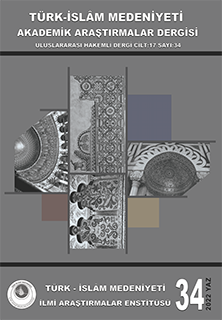The National Architecture Period Graveyards in The Tomb of Sultan Mahmut II
Keywords:
Tomb, Sarcophagus, National Architecture Period.Abstract
National Architecture Period, which includes the last years of Ottoman Empire and the first years of Turkish Republic, gets inspiration from Seljuk elements and Ottoman Classical Period elements and gives examples of these periods. These features are also seen in the gravestones within the time and some successful works which show specific features are among the products of this period. Meanwhile, the location of the graves and the social status of buried people affect the success of the gravestones. Graveyards which draw attention with their monumental sizes and intensive adornments are in the form of sarcophagus tombs. The lively aspects are achieved by carrying corners of the aspects and middle parts from surfaces and the surfaces of sarcophagi are decorated with palmet, rumi, lotus ornament bands, hoods, Turkish triangles, muqarnas and rosettes.
References
AKIN, G., 1989, “Divanyolu Küresi”, Tarih ve Toplum, S: 70, C:12, İstanbul, s. 21-
BATUR, A., 2008, “Mimar Kemalettin Yapılar Rehberi”, TMMOB Mimarlar Odası İstanbul Büyükkent Şubesi, İstanbul, s. 60.
BOSTAN, H., 2008, “Sait Halim Paşa”, D.İ.A., C: 35, İstanbul, s. 557-560.
BULUT, M., 2013, “Ölümünün 100. Yılında Mahmut Şevket Paşa’nın Türbesi” FSM İlmi Araştırmalar İnsan ve Toplum Bilimleri Dergisi, S. 1 İstanbul, s. 93-107.
BULUT, M., 2012, “Sultan II. Mahmut Türbesi Haziresi”, M.Ü. Türkiyat Araştırmaları Enstitüsü, Yayınlanmamış Doktora Tezi, İstanbul.
BURÇOĞLU, N. K., 2001, “Matbaacı Osman Bey”, Tarih ve Toplum Dergisi, S: 209, İstanbul, s. 312-320.
BÜLBÜL, K., 2006, “Said Halim Paşa”, Kadim Yayınları, Ankara.
ELDEM, E., 2005, “İstanbul’da Ölüm Osmanlı-İslam Kültüründe Ölüm ve Ritüelleri”, Garanti Bankası Osmanlı Bankası Arşiv ve Araştırma Merkezi, İstanbul.
HASEKİ, M., 1977, “Plastik Açıdan Türk Mezar Taşları”, İstanbul Devlet Güzel Sanatlar Akademisi, İstanbul.
KOCAKAPLAN, İ., 2009, “Ziya Gökalp, Türk Edebiyatı Vakfı Yayınları”, İstanbul.
ÖZCAN, A. R., 2007, “Türk Kültür ve Medeniyeti Tarihinde Fatih Külliyesi Hazire”, İBB. Kültür A.Ş., İstanbul.
PAKALIN, M. Z., 2008, “Sicil-i Osmani Zeyli Son Devir Osmanlı Meşhurları Ansiklopedisi”, Haz: Gülbadi Alan, TTK, Ankara.
SANER, T., 1998, “19. Yüzyıl İstanbul Mimarlığında Oryantalizm”, Pera Turizm ve Ticaret Yayınları, İstanbul.
SEÇGİN, N., 2000, “Eyüp Sultan Hazirelerindeki Mimari Düzenlemeli Lahitler”, Tarihi Kültürü ve Sanatıyla IV. Eyüp Sultan Sempozyumu (5-7 Mayıs, 2000), İstanbul, s. 298-309.
ŞEHSUVAROĞLU, L., 2003, “Ziya Gökalp”, Alternatif Yayınları., Ankara.
TEKTAŞ, N., 2002, “Sadrazamlar, Osmanlı’da İkinci Adam Saltanatı”, Çatı Kitapları, İstanbul.
UÇMAN, A., “Ziya Gökalp”, Yaşamları ve Yapıtlarıyla Osmanlılar
Ansiklopedisi, C: 2, s. 699-700.
YAĞMURDERELİ, Z., 1982, “Ziya Gökalp’in Ölüm Yılında Yazılanlardan Seçmeler”, Kültür Bakanlığı Yayınları, Ankara.
YAVUZ, Y., 1994, ”Mahmut Şevket Paşa Türbesi”, İstanbul Ansiklopedisi, Tarih Vakfı, İstanbul, C: 5, s. 272-273.
ARMAĞAN, M., 2009, “İstanbul’da Ilk Kur’an Ne Zaman Basıldı?”, Zaman Gazetesi, 11.10.2009.
Downloads
Published
How to Cite
Issue
Section
License

This work is licensed under a Creative Commons Attribution-NonCommercial 4.0 International License.







